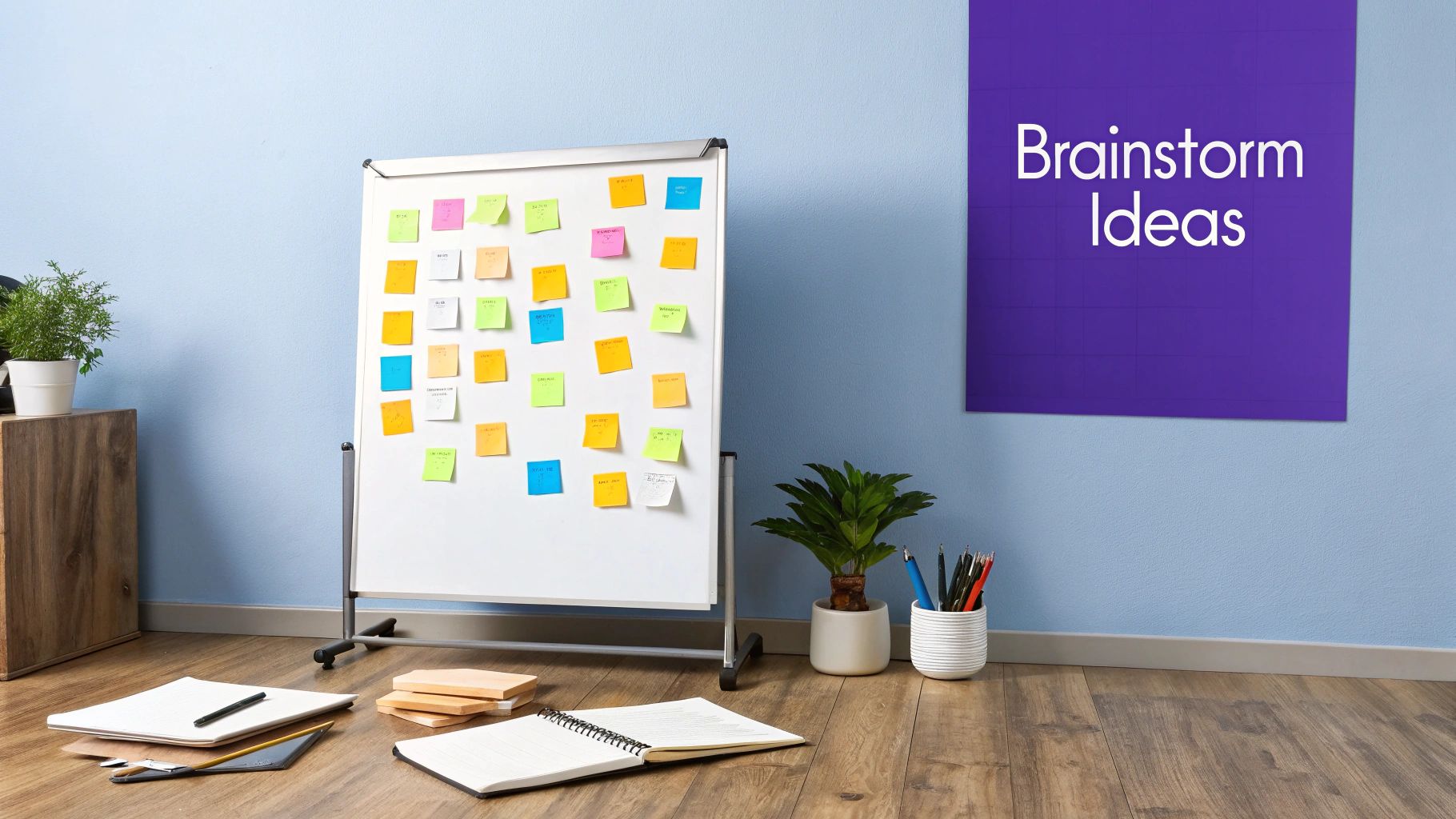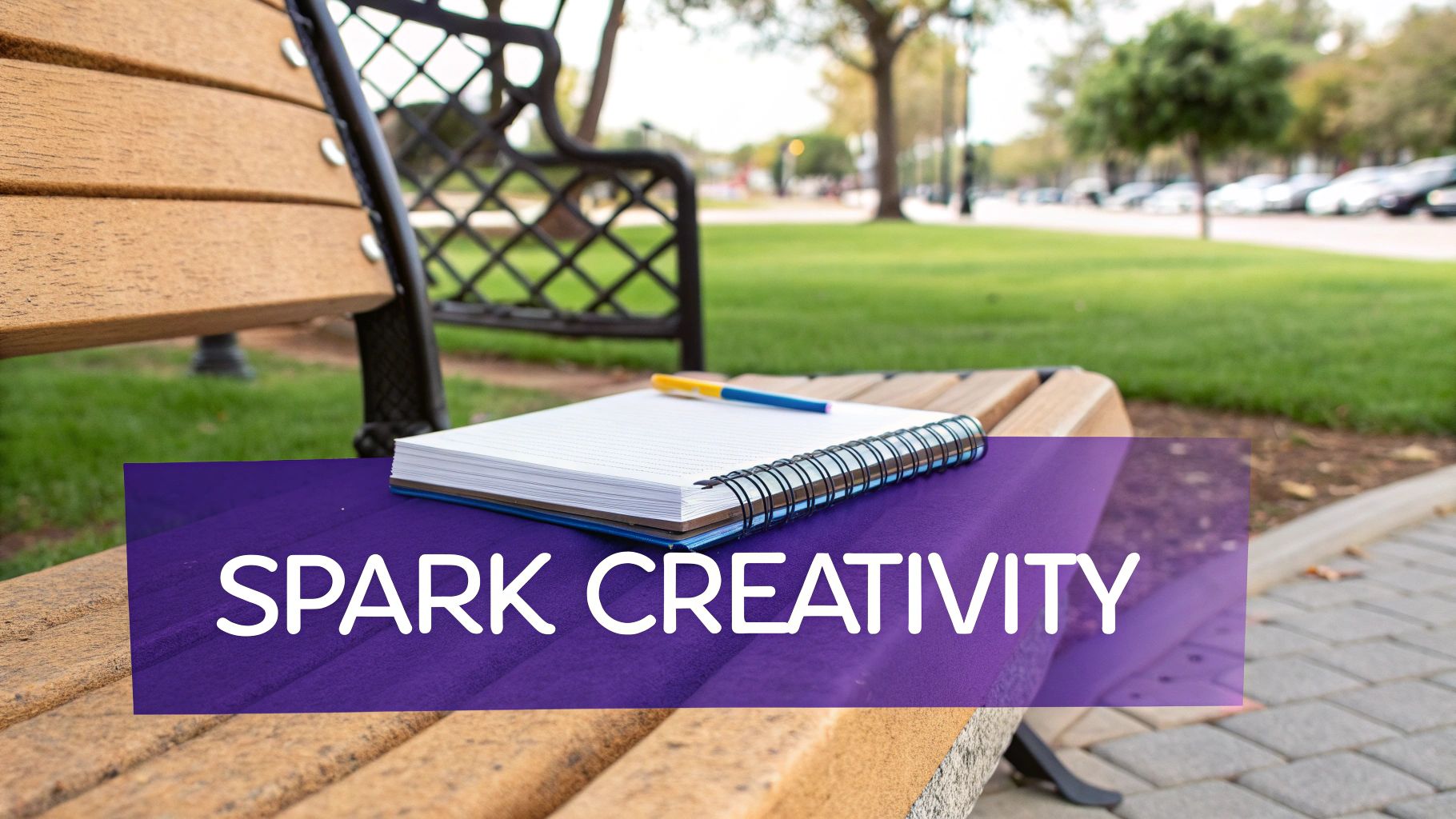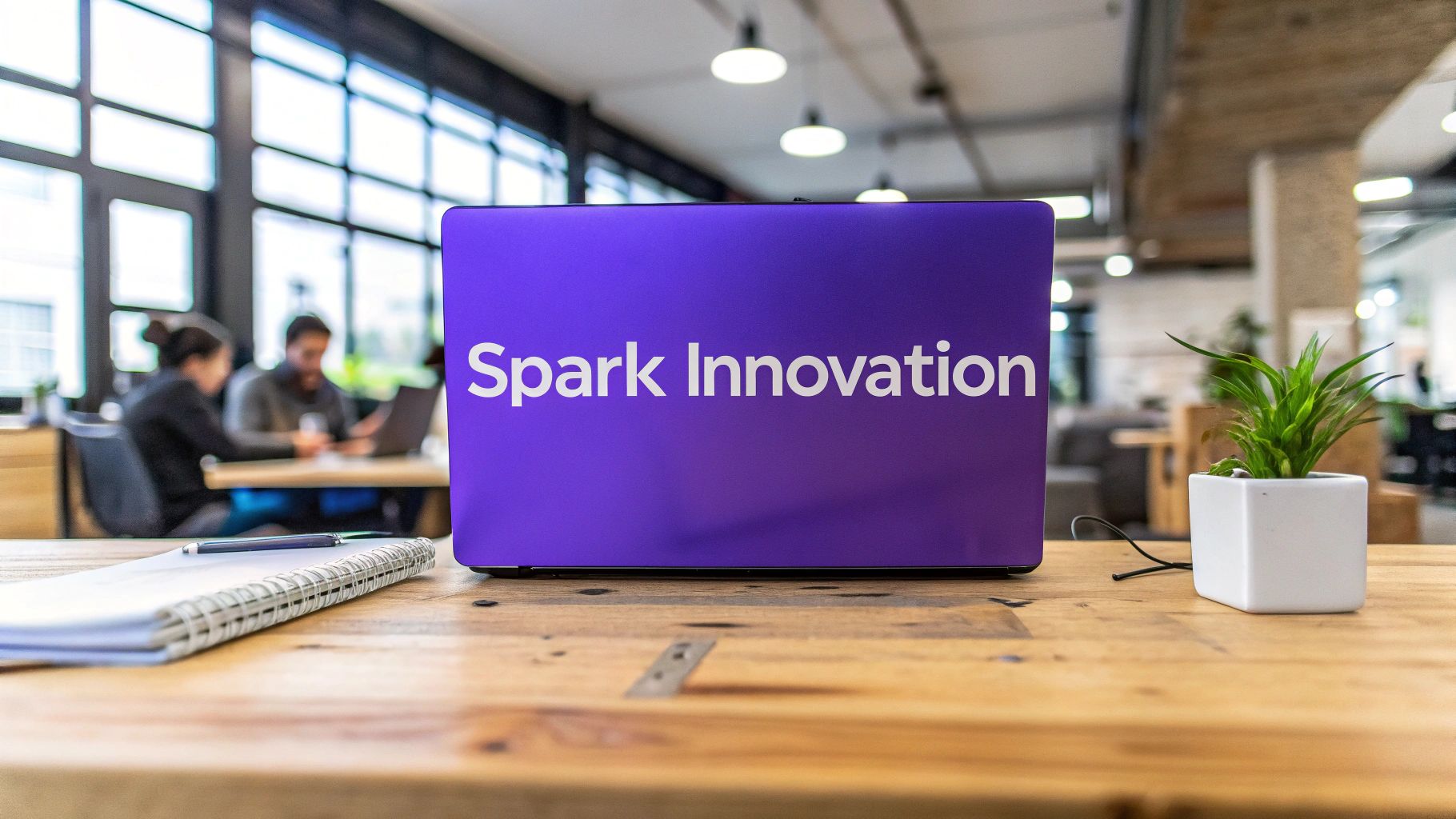The Evolution of Creative Thinking: From Brainstorming to Now
Defining idea generation today requires understanding its historical development. For decades, brainstorming, popularized by Alex Osborn in the 1950s, dominated the field. Osborn’s 1957 book Applied Imagination championed group brainstorming, arguing it led to more creative stimuli and interactions. This formed the foundation for how many organizations approached idea generation.
However, the effectiveness of group brainstorming has been continually debated. While it remains a common practice, its efficacy compared to individual ideation has been questioned. The concept of idea generation, particularly brainstorming, has a rich history originating in the 1950s. Alex Osborn, in his 1957 book Applied Imagination, introduced the term and promoted group brainstorming as a way to increase creative output. However, research suggests that while groups can produce many ideas, individual work often leads to higher quality.
For example, studies have found that individuals working alone generate more ideas than those in groups, and the quality of these ideas is comparable, if not superior. This underscores the need for a balance between group collaboration and individual creativity. Explore this further here.
Beyond Brainstorming: Modern Approaches to Idea Generation
Today, defining idea generation extends far beyond traditional brainstorming. Modern approaches often combine individual and group work, leveraging the strengths of each. Technology also plays a crucial role, with tools like Bulby facilitating remote team brainstorming and offering structured exercises. This allows for asynchronous idea contribution and helps overcome some of the limitations of traditional brainstorming sessions.
The Rise of Structured Ideation
Furthermore, structured ideation methods like design thinking have become increasingly important. Design thinking, a human-centered approach, emphasizes understanding user needs and rapidly prototyping solutions. This provides a more focused approach to idea generation, concentrating on problem-solving and iterative feedback.
The Future of Idea Generation
Ultimately, effectively defining idea generation now means recognizing the nuances of different techniques and applying them strategically. For instance, individual brainstorming might yield higher quality initial ideas, but group discussions can be essential for refining and developing them further. This interplay between individual and collaborative thinking, enhanced by digital tools and structured methods, will shape the future of idea generation.
Core Principles to Define Generating Ideas That Work

Defining how to generate effective ideas means understanding the core principles behind successful ideation. It’s not about random thoughts. It’s about creating an environment and process that delivers meaningful, actionable results. This involves understanding both the psychological and structural elements involved.
The Power of Divergent and Convergent Thinking
A crucial aspect of idea generation is the interplay between divergent and convergent thinking. Divergent thinking is the expansive, exploratory phase. Here, we embrace unusual possibilities and challenge existing assumptions. Convergent thinking is the focused phase. This is where we analyze, refine, and select the most promising ideas. Effective ideation needs both: freedom to explore and discipline to focus.
A successful ideation process requires balance.
The Role of Strategic Constraints
Limitations can actually boost creativity. Defining idea generation often means setting strategic constraints. These constraints might relate to budget, time, or resources. Instead of stifling creativity, they can enhance it. Limited resources can force teams to be more resourceful, leading to unexpected, innovative solutions. Clear boundaries are important for creativity to flourish.
Constraints encourage resourcefulness.
Cultivating Psychological Safety
A psychologically safe environment is critical for successful ideation. Team members need to feel comfortable taking risks, sharing unusual ideas, and admitting mistakes. This is particularly important for team-based ideation. When people feel safe to express themselves without judgment, they contribute more effectively, leading to a richer pool of ideas. Learn more about this in this helpful article: How to master ideation.
Psychological safety encourages participation.
To further illustrate the key components of effective ideation, let’s examine the following table:
The following table outlines the four key dimensions for generating effective ideas. It illustrates how different elements interact to produce innovative outcomes.
| Dimension | Key Elements | Impact on Idea Quality | Common Obstacles |
|---|---|---|---|
| Divergent Thinking | Brainstorming, mind mapping, freewriting | Generates a wide range of ideas, explores new possibilities | Fear of judgment, groupthink, lack of focus |
| Convergent Thinking | Critical thinking, analysis, evaluation | Refines and selects the most promising ideas, improves feasibility | Premature closure, anchoring bias, insufficient data |
| Strategic Constraints | Resource limitations, time limits, specific goals | Enhances creativity by focusing efforts, promotes resourcefulness | Overly restrictive constraints, lack of clarity, resistance to limitations |
| Psychological Safety | Trust, respect, open communication | Encourages participation, fosters risk-taking, promotes diverse perspectives | Fear of failure, interpersonal conflict, lack of leadership support |
This table summarizes the key elements that drive successful idea generation. By understanding these dimensions, teams can optimize their ideation process and maximize their creative output.
Frameworks for Breakthrough Solutions
Many frameworks exist to guide the ideation process. Defining idea generation can be approached through structured methodologies like design thinking. Design thinking emphasizes empathy and iterative prototyping. This provides a framework to move from problem to solution. Tools like Bulby, designed for remote teams, can further enhance the process by adding structure and facilitating collaboration.
Frameworks offer valuable structure.
Balancing Individual and Collaborative Ideation
Collaboration is important, but individual ideation is valuable too. Research suggests individuals working alone can sometimes generate higher-quality ideas than groups. Defining idea generation should include opportunities for individual brainstorming and reflection. This allows individuals to explore their unique perspectives before sharing with the group for further development. This balanced approach ensures a more comprehensive and effective process.
Individual ideation can lead to higher quality ideas.
Solo Vs. Team Ideation: Finding Your Creative Sweet Spot

Generating ideas isn’t just about group brainstorming. It’s about knowing when individual thinking is best and when teamwork is more effective. This section explores the balance between solo and team ideation. We’ll also look at how to structure sessions that use both individual thought and group dynamics.
The Power of Introspection: Solo Ideation
Solo ideation allows for deep, focused thinking. It lets individuals explore their own perspectives without immediate judgment. This concentration can lead to breakthroughs and innovative solutions. Many artists and writers, for example, find their best work comes from periods of solitary creation. This focused time helps them fully develop their ideas before sharing them.
Harnessing Collective Intelligence: Team Ideation
Team ideation uses the different experiences and perspectives of a group. This collaborative approach generates a wider range of ideas and sparks unexpected connections. Group discussions can refine and develop initial concepts, pushing them further. However, team ideation needs to be managed carefully. This helps avoid groupthink and ensures everyone participates equally.
Finding the Right Blend: Balancing Solo and Team Approaches
Effective idea generation often combines solo and team approaches. Individual brainstorming can produce a larger number of initial ideas. Moving to a group setting allows these ideas to be developed and refined through discussion and feedback. Tools like Bulby can be especially helpful in this transition, making it easy to move between solo and team ideation.
This blend maximizes the strengths of both approaches, creating a more comprehensive and effective ideation process. Research shows how interpersonal dynamics impact idea generation. The quality of ideas is affected by the personalities of both the innovator and their peers. Learn more about the interplay between personality and ideation here.
Structuring Effective Team Ideation Sessions
For productive sessions, start with clearly defined goals and a structured agenda. This keeps the team focused. A psychologically safe environment is crucial. All members should feel comfortable sharing their thoughts without fear of judgment. This encourages participation and diverse perspectives.
Overcoming Groupthink and Encouraging Authentic Participation
Techniques like brainwriting or anonymous idea submission can overcome groupthink. These methods allow individuals to contribute independently before group discussion. This ensures everyone’s voice is heard. Assigning rotating roles, such as a devil’s advocate, encourages critical thinking and challenges assumptions. This leads to stronger ideas.
Building on Individual Insights Through Structured Collaboration
After generating initial ideas, structured collaboration techniques are key for development. Affinity mapping helps group similar ideas, revealing patterns and areas of focus. Dot voting lets the team prioritize the best concepts democratically. This builds buy-in and shared ownership. Finally, prototyping and testing chosen ideas can validate feasibility and refine them based on feedback. By encouraging individual reflection and collaborative refinement, idea generation becomes a dynamic and powerful process.
Digital Transformation of Idea Generation

Technology has fundamentally reshaped how we generate ideas. From early feedback collection methods to today’s advanced software, technology has always played a vital role. Understanding this digital transformation is crucial for staying competitive.
Historically, idea management relied on basic systems like suggestion boxes. These methods often lacked effective feedback and review processes, hindering true innovation. Interestingly, these systems date back over a century.
Early systems often failed due to a lack of feedback and cumbersome reviews. The advent of the internet and software in the late 1990s and early 2000s revitalized idea management. Automated reviews, instant feedback, and reward systems became possible, demonstrating technology’s impact on improving efficiency. Learn more about the history of idea management here.
AI-Powered Brainstorming and Virtual Collaboration
Today, digital tools are essential for idea generation. AI-powered brainstorming tools analyze large datasets to identify trends and suggest new approaches. Immersive virtual environments are increasingly used for collaboration, enabling teams to visualize and interact with ideas in innovative ways. This fosters connections across geographical boundaries, bringing diverse perspectives together and accelerating innovation. Check out this helpful resource on virtual brainstorming: How to master virtual brainstorming.
Choosing the Right Tools and Measuring Impact
The abundance of digital tools presents challenges. Choosing tools that align with your goals and integrate with existing workflows is critical. For instance, a team focused on rapid prototyping might prioritize a platform supporting real-time collaboration and visual modeling. Measuring the impact of these technologies on both the quantity and quality of ideas is key. This means establishing clear metrics and tracking progress.
Case Studies and Practical Guidance
Many organizations have successfully integrated digital platforms into their ideation processes. One example is a global marketing agency that used a virtual brainstorming platform to connect global team members. This resulted in a 30% increase in unique campaign concepts. However, technology is just one part of the equation. Practical guidance on using these tools effectively, including best practices for virtual brainstorming and managing digital idea repositories, is crucial. This involves promoting digital fluency and providing adequate training.
The Future of Idea Generation in a Digital World
The digital transformation of idea generation is an ongoing process. As technology continues to advance, we will see even more powerful tools. This will further blur the lines between human creativity and artificial intelligence, emphasizing the need for continuous learning and adaptation. By embracing digital tools and integrating them strategically, you can unlock new levels of innovation and achieve breakthrough results. This includes exploring technologies like retrieval-augmented generation (RAG), allowing AI models to access and process real-time information, enhancing the accuracy and relevance of generated ideas.
Design Thinking: From Problem to Breakthrough Solution

Generating effective ideas often requires a structured approach. Design thinking is one such methodology, providing a reliable framework for consistent innovation. It’s a human-centered process that guides teams from problem identification to creating effective solutions. This section explores the core phases of design thinking and how they contribute to breakthrough ideas.
Empathize: Understanding the Human Need
The first phase of design thinking is empathizing with the user. This means truly understanding their perspective on the problem through careful listening and observation. Techniques like empathy mapping and user interviews can reveal unspoken needs and motivations. This user-centric approach ensures that generated ideas address the root of the problem, not just superficial symptoms. This fundamental understanding forms the foundation for effective solutions.
Define: Framing the Right Challenge
Next, the team must clearly define the problem. This involves synthesizing information gathered during the empathize phase and articulating the core challenge in a concise problem statement. A well-defined problem statement provides focus and direction for the next stage of ideation. For instance, instead of “Improve customer satisfaction,” a more effective problem statement could be, “Reduce customer wait times during peak hours.” This clarifies the challenge, making it easier to generate targeted solutions. You might find this helpful: How to master Creative Problem Solving.
Ideate: Generating a Wide Range of Solutions
The ideation phase is central to design thinking. Here, the team generates a wide array of potential solutions. Techniques like brainstorming, “How Might We” questions, and rapid ideation exercises stimulate creative thinking and explore diverse possibilities. Bulby is a powerful brainstorming tool designed for remote teams and can further enhance this process. Bulby’s AI-powered guidance and structured exercises help teams overcome creative blocks and generate more innovative solutions. Design thinking, a methodology originating in the 1950s and 1960s, has become a prominent approach to innovation. It integrates human, technological, and strategic needs. Learn more about the history of design thinking here.
Prototype: Bringing Ideas to Life
The prototype phase involves creating tangible representations of the most promising ideas. These prototypes can range from simple, low-fidelity mockups to more sophisticated functional models. The goal is to quickly bring ideas to life and test their feasibility. Prototyping allows teams to identify potential flaws and refine solutions early, saving both time and resources. This hands-on approach deepens understanding of the problem and its solutions.
Test: Validating and Refining Solutions
The final phase of design thinking is testing. This means gathering feedback on the prototypes from users and stakeholders. Testing helps validate the effectiveness of the proposed solutions and pinpoint areas for improvement. This iterative process of prototyping and testing helps refine ideas and ensures they truly meet user needs. The goal is to create solutions that are both desirable and feasible. This iterative approach is crucial for developing effective user-centered solutions.
Turning Brilliant Ideas Into Actionable Realities
Generating ideas isn’t just about the initial spark; it’s about what happens next. Many great ideas never get off the ground because the process falters between ideation and implementation. This section explores how to bridge that gap and turn brilliant ideas into tangible results.
Evaluating Ideas Objectively: Avoiding Cognitive Bias
A crucial step in generating effective ideas involves objective evaluation. We need frameworks that help us avoid common thinking pitfalls that can lead to poor decisions.
For example, confirmation bias can make us favor ideas that align with our existing beliefs. Anchoring bias might make us overvalue the first idea, even if better ones come along later.
By establishing clear evaluation criteria and getting diverse perspectives, we can mitigate these biases and make more informed choices.
From Concept to Roadmap: Building a Path to Execution
Once we’ve objectively evaluated our ideas, we need a roadmap for implementation. This means defining specific steps, assigning responsibilities, and setting realistic timelines.
This roadmap transforms abstract concepts into concrete actions. It also allows for flexibility and adaptation as the project progresses.
This brings us to a vital point in the innovation journey. Idea generation can produce many ideas. Selecting the best ones is crucial and often involves narrowing down the options. Technological advancements significantly influence both the objectives and processes of idea generation and selection. The telephone, for instance, revolutionized communication and spurred new innovations, such as developing signal transmission methods. Find more statistics here: Idea Generation and Selection
Building Organizational Support and Overcoming Resistance
New ideas often face resistance within organizations. This can come from fear of change, perceived lack of resources, or established procedures.
Building organizational support is essential for successful implementation. This involves communicating the idea’s value, addressing concerns, and involving key stakeholders.
Establishing Feedback Loops and Iterative Refinement
Implementation is not a one-time event. Establishing feedback loops is crucial for iterative refinement. This involves gathering data on the idea’s performance, analyzing results, and adjusting as needed.
This ongoing feedback cycle allows for continuous improvement and ensures the idea stays relevant and effective.
To help evaluate and select the most promising ideas, a structured approach is essential. The following table provides a weighted matrix for scoring ideas based on key criteria:
Idea Evaluation Matrix for Selection: A structured approach to evaluating and selecting the most promising ideas based on multiple criteria
| Evaluation Criteria | Weight | Scoring Guide | Implementation Considerations |
|---|---|---|---|
| Market Potential | 30% | 1-5 (1=Low, 5=High) | Market research, competitive analysis |
| Feasibility | 25% | 1-5 (1=Low, 5=High) | Resource assessment, technical evaluation |
| Strategic Alignment | 20% | 1-5 (1=Low, 5=High) | Alignment with organizational goals |
| Impact | 15% | 1-5 (1=Low, 5=High) | Potential impact on key metrics |
| Innovation | 10% | 1-5 (1=Low, 5=High) | Novelty and differentiation |
This matrix helps compare ideas across different areas and prioritize those with the highest potential. Market potential, feasibility, and strategic alignment carry the most weight in the decision-making process.
From brainstorming to execution, managing the journey of an idea is crucial. By embracing objective evaluation, strategic planning, and continuous feedback, we can greatly increase the chances of success. Looking for a tool to improve your team’s brainstorming? Check out Bulby, a platform designed for remote teams: https://www.bulby.com

